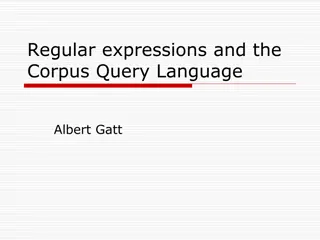Delving into Corpus-Based Information on Academic Speaking
Exploring high-frequency features like chunking and vague category marking in academic speaking, and how these manifest from conversational habits. Analysis includes 3-word and 4-word chunks commonly found in academic conversations. The comparison of academic versus social language use provides valuable insights into linguistic patterns. The content also delves into the nuances between "in terms of" and "in the sense that" in academic discourse.
Download Presentation

Please find below an Image/Link to download the presentation.
The content on the website is provided AS IS for your information and personal use only. It may not be sold, licensed, or shared on other websites without obtaining consent from the author.If you encounter any issues during the download, it is possible that the publisher has removed the file from their server.
You are allowed to download the files provided on this website for personal or commercial use, subject to the condition that they are used lawfully. All files are the property of their respective owners.
The content on the website is provided AS IS for your information and personal use only. It may not be sold, licensed, or shared on other websites without obtaining consent from the author.
E N D
Presentation Transcript
What can we do with corpus-based information about academic speaking? Mike McCarthy
Summary: Two high-frequency features of conversation Chunking Vague category marking How these are carried over into academic speaking
3-word chunks: academic CANC ACAD 1 A LOT OF 2 I DON'T KNOW 3 YOU WANT TO 4 ONE OF THE 5 YOU HAVE TO 6 GOING TO BE 7 YOU'VE GOT TO 8 THIS IS THE 9 IN TERMS OF 10 THIS IS A CLAS 1 A LOT OF 2 DO YOU THINK 3 IN TERMS OF 4 AND SO ON 5 YOU HAVE TO 6 UH HUH AND 7 YOU NEED TO 8 YOU WANT TO 9 I DON'T KNOW 10 A LITTLE BIT
3-word chunks: academic CANC ACAD 1 A LOT OF 2 I DON'T KNOW 3 YOU WANT TO 4 ONE OF THE 5 YOU HAVE TO 6 GOING TO BE 7 YOU'VE GOT TO 8 THIS IS THE 9 IN TERMS OF 10 THIS IS A CLAS 1 A LOT OF 2 DO YOU THINK 3 IN TERMS OF 4 AND SO ON 5 YOU HAVE TO 6 UH HUH AND 7 YOU NEED TO 8 YOU WANT TO 9 I DON'T KNOW 10 A LITTLE BIT
In terms of: academic vs social per 1m Academic combined Social & intimate 0 50 100 150 200 250 300 350
4-wd chunks: sense CANC ACAD 1 IN THE SENSE THAT 2 DOES THAT MAKE SENSE 3 A SENSE IN WHICH 4 SO IN A SENSE 5 IN A SENSE THAT CLAS 1 IN THE SENSE OF 2 IN THE SENSE THAT 3 IS IN THE SENSE 4 THE SENSE OF WHETHER 5 DOES THAT MAKE SENSE
4-wd chunks: sense CANC ACAD 1 IN THE SENSE THAT 2 DOES THAT MAKE SENSE 3 A SENSE IN WHICH 4 SO IN A SENSE 5 IN A SENSE THAT CLAS 1 IN THE SENSE OF 2 IN THE SENSE THAT 3 IS IN THE SENSE 4 THE SENSE OF WHETHER 5 DOES THAT MAKE SENSE
In the sense that: academic vs social per 1m Academic combined Social & intimate 0 5 10 15 20 25 30 35
In terms of or in the sense that? But there's a difference, [in the sense that] if an exclusion clause falls into a particular definition, then it's subject to the reasonableness test. Speak to companies, do questionnaires. You need quantitative and qualitative. You know, quantitative [in terms of] how many questionnaires you get back. Say you get fifty or sixty or whatever. The qualitative [in terms of] in the discussions when you get information from the companies and that. It's suggesting something about the difficulty of modern living sort of, you know, [in the sense that] it's all fragmented.
In terms of or in the sense that? But there's a difference, [in the sense that] if an exclusion clause falls into a particular definition, then it's subject to the reasonableness test. Speak to companies, do questionnaires. You need quantitative and qualitative. You know, quantitative [in terms of] how many questionnaires you get back. Say you get fifty or sixty or whatever. The qualitative [in terms of] in the discussions when you get information from the companies and that. It's suggesting something about the difficulty of modern living sort of, you know, [in the sense that] it's all fragmented.
Vague category markers <$1> Mm. But er yeah. Have you done anything on the intentionalist fallacy and the effective fallacy and that sort of thing? Well that that's quite important because I don't think you can ever demonstrate what a writer's intentions are. [lit. stylistics supervision CANC ACAD]
Vague category markers Before we go on to the third lecture where we talk about the liver and pancreas and so on, Later on by the time of birth the liver constitutes about five percent of the weight of the e= embryo and blood cell production is moving then to the bone marrow and so on. [medicine lecture CANC ACAD] Okay. So as you go around actually in spots like this where the actual material is exposed you see the bank is made up of obviously soil and stones and so forth. [archaeology field trip CANC ACAD]
CLAS Tourism lecture I mentioned in the last class there that, you know, from employment legislation and the idea of human resource policies and human resource developments and time off and leisure time and time in lieu of extra hours overtime worked and all that kind of thing, that developed concurrently with increased travel behaviour, am, internationally, okay. So whenever you're asked to think about what are the factors that sort of influence travel development, one area is the social and cultural element of it. And with that you talk about your standard template, your social demographic, am, statistics, your populations statistics, your age profile, your population pyramids, your tree pyramids that you would have done in geography in school and things like that, okay.
From the corpus In academic speaking, some of the most common vague expressions of this kind are: Adding expressions and so on etcetera and so forth etcetera etcetera and so on and so forth Alternatives or whatever or something or something like that
Error alert! Vague expressions are also common in informal conversations (e.g. and stuff, and that kind of stuff). Be careful not to use these in formal contexts. If in doubt, only use and so on, and so forth and etcetera. You can use vague expressions in academic speaking, but avoid them in your writing, apart from etcetera. In academic writing etcetera is usually written as etc. with a full stop.
Vague expressions: practice Listen to extracts from other presentations on plastics. Write the vague expressions the speakers use. Then practise repeating the extracts. Practise again using other vague expressions. The bioplastics that are currently produced tend to be made from agricultural food products such as corn, potatoes, rice, [and so on and so forth], though corn is still the main source. To be approved by the BPI, which stands for the Biodegradable Products Institute, bioplastic materials must not contain large amounts of heavy metals such as lead, mercury [and so on]. Bioplastics are widely used in the food industry in drinks bottles, in packaging of fruit and vegetables [etcetera etcetera] but these are not always the answer to environmentalists concerns.
Vague expressions: practice Listen to extracts from other presentations on plastics. Write the vague expressions the speakers use. Then practise repeating the extracts. Practise again using other vague expressions. The bioplastics that are currently produced tend to be made from agricultural food products such as corn, potatoes, rice, [and so on and so forth], though corn is still the main source. To be approved by the BPI, which stands for the Biodegradable Products Institute, bioplastic materials must not contain large amounts of heavy metals such as lead, mercury [and so on]. Bioplastics are widely used in the food industry in drinks bottles, in packaging of fruit and vegetables [etcetera etcetera] but these are not always the answer to environmentalists concerns.
CLAS Tourism lecture I mentioned in the last class there that, you know, from employment legislation and the idea of human resource policies and human resource developments and time off and leisure time and time in lieu of extra hours overtime worked and all that kind of thing, that developed concurrently with increased travel behaviour, am, internationally, okay. So whenever you're asked to think about what are the factors that sort of influence travel development, one area is the social and cultural element of it. And with that you talk about your standard template, your social demographic, am, statistics, your populations statistics, your age profile, your population pyramids, your tree pyramids that you would have done in geography in school and things like that, okay.
Margaret Healys CLAS data <$NS505> you spend so long focusing on balancing your money, balancing your credit cards, balancing your cash, making sure everything is right, that the whole area of credit bills tend to be not viewed as important or they paid you credit cards or something, you have that money. The money you don't have is your credit bills So there's a lot of annoying little issues caused by walkouts, I suppose with the most important being your financial loss in your hotel
Conclusion Features are carried over from conversation to academic discourse Items may be academic-specific and relationships discipline-specific Academic chunks often reflect the organisation and packaging of academic discourse Vague category markers refer to in-group understandings Collaborative exploration of items is important
In terms of ... (MICASE) 160 140 120 100 80 60 40 20 0 Social Humanities Biological and Health Sciences Physical Sciences and Engineering Sciences and Education























